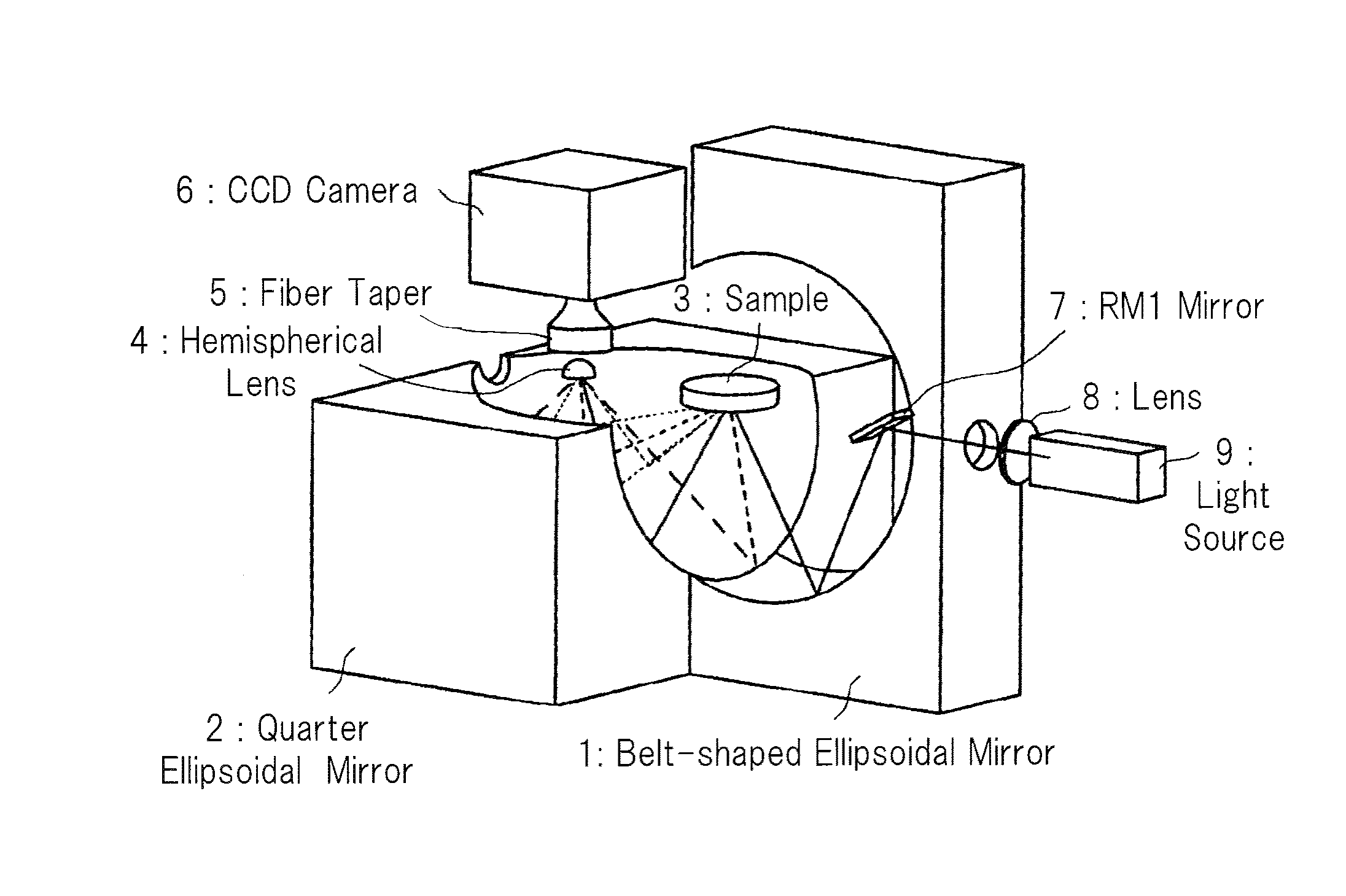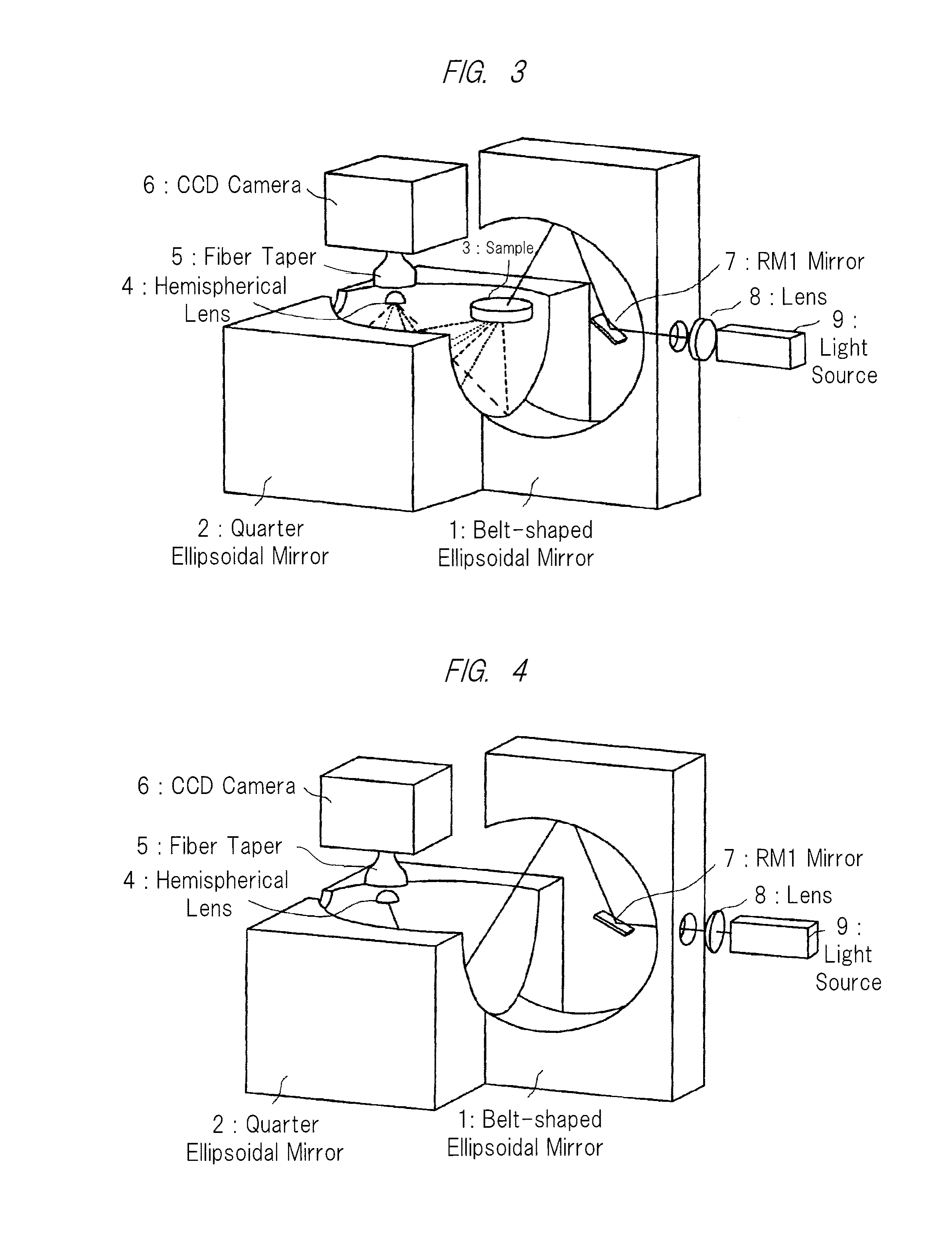Optical characteristic measuring apparatus
a measuring apparatus and optical characteristic technology, applied in the direction of optical radiation measurement, instruments, spectrophotometry/monochromators, etc., can solve the problems of inapplicability, measurement reflectance of the sample becomes larger than an actual value, and the measurement precision of measured quantities is different from each other. to achieve the effect of wide wavelength region
- Summary
- Abstract
- Description
- Claims
- Application Information
AI Technical Summary
Benefits of technology
Problems solved by technology
Method used
Image
Examples
first embodiment
[0060]A representative structure, an evaluation result and the like of an optical characteristic measuring apparatus for measuring scattered light from a sample will be described below. FIG. 1 is a perspective view showing a representative structure of a first embodiment and showing a reflection measuring arrangement. FIG. 2 is a cross-sectional view schematically showing the apparatus of FIG. 1 and showing a reflection measuring mode. FIG. 3 is a view showing a transmission measuring arrangement. FIG. 4 is a view showing a background measuring arrangement. FIG. 5 is a view showing a hemispherical detection optical system. FIG. 6 is a view showing a belt-shape ellipsoidal mirror. FIG. 7 is a view showing a quarter ellipsoidal mirror. FIG. 8 is a view showing an octantal ellipsoidal mirror. FIGS. 9, 10, and 11 are views showing the rotation of the belt-shape ellipsoidal mirror.
[0061]Firstly, as a precondition for the present invention, a double ellipsoidal optical system will be desc...
second embodiment
[0093]In the first embodiment, the example using a hemispherical lens, a fiber taper, and a CCD camera, and the example using a hemispherical lens, a fiber taper, and a photo diode detector, as a hemispherical detection optical system, are described. In a second embodiment, the example using a convex lens system instead of the fiber taper will be described with reference to FIG. 22. In FIG. 22, a point at which five solid lines, and a dashed-dotted line, and a dashed-two dotted line gather is a focal point F2 of the ellipsoidal mirror. The center of the hemispherical lens is disposed so as to coincide with the focal point F2 of the ellipsoidal mirror. In addition, the bottom surface of the hemispherical lens is disposed parallel to an edge face of the quarter ellipsoidal mirror. This prevents the hemispherical detection optical system from making a shadow inside the ellipsoidal mirror, and therefore the hemispherical lens can concentrate all light collected from the 2π space on the ...
third embodiment
[0097]In the second embodiment, one example of using a hemispherical lens, convex lenses, and a CCD camera (or a photo diode detector) is described as a hemispherical detection optical system. In the third embodiment, one example of using a rotational parabolic mirror 14 instead of the hemispherical lens 4 will be described with reference to FIG. 23. A hemispherical detection optical system according to the third embodiment comprises a rotational parabolic mirror 14, a convex lens system (convex lens) 13, and a CCD camera 6. The rotational parabolic mirror 14 has a shape cut (opening) along a plane perpendicular to the axis of rotation and passing through the focal point, and has a polished inner surface, and this mirror is disposed so that the cut plane (opening) passing through the focal point of this mirror is parallel to the edge of the quarter ellipsoidal mirror, and the focal point of this mirror coincides with that of the quarter ellipsoidal mirror.
[0098]A dashed-dotted line ...
PUM
| Property | Measurement | Unit |
|---|---|---|
| reflectance | aaaaa | aaaaa |
| time | aaaaa | aaaaa |
| length | aaaaa | aaaaa |
Abstract
Description
Claims
Application Information
 Login to View More
Login to View More - R&D
- Intellectual Property
- Life Sciences
- Materials
- Tech Scout
- Unparalleled Data Quality
- Higher Quality Content
- 60% Fewer Hallucinations
Browse by: Latest US Patents, China's latest patents, Technical Efficacy Thesaurus, Application Domain, Technology Topic, Popular Technical Reports.
© 2025 PatSnap. All rights reserved.Legal|Privacy policy|Modern Slavery Act Transparency Statement|Sitemap|About US| Contact US: help@patsnap.com



